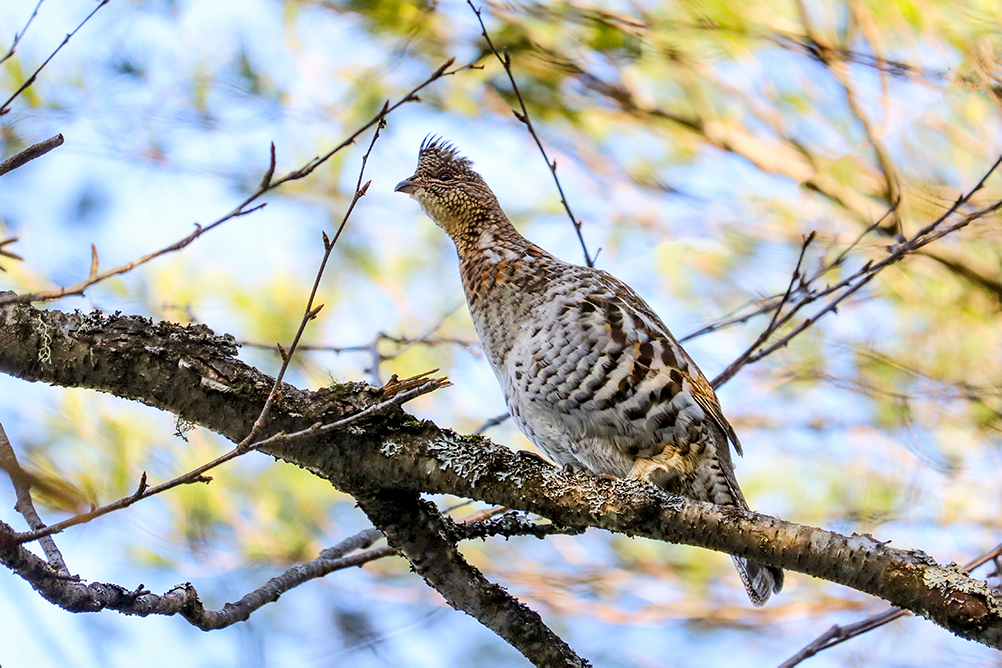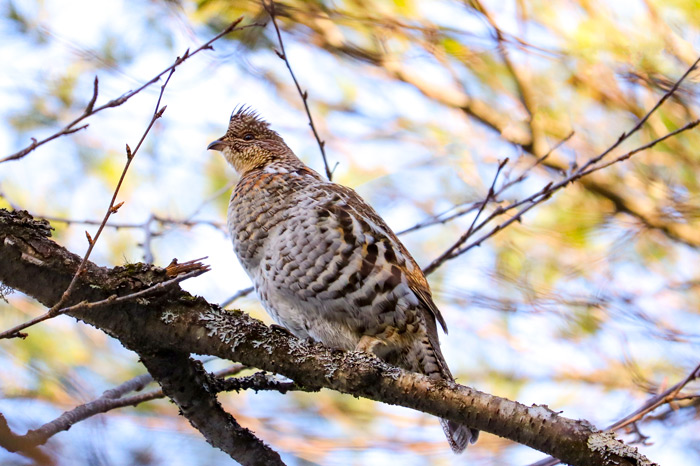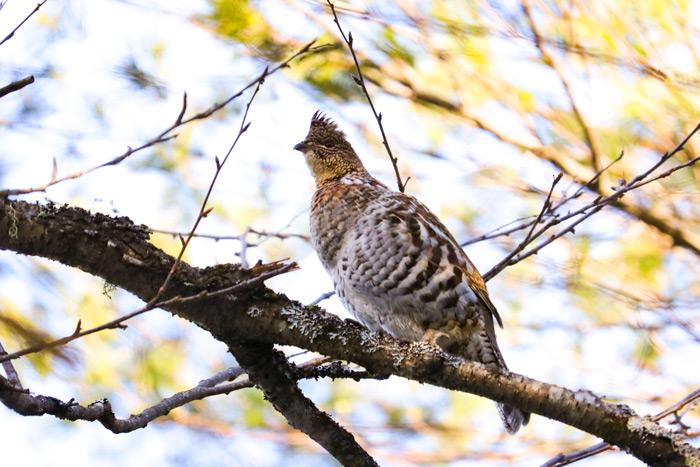
Finding a ruffed grouse in the woods.
A few weeks ago while I walking in the woods, I spotted a female ruffed grouse perching high up in a birch tree. This was quite an exciting visual treat. Before moving to Maine, I had never seen this species of bird before. Since seeing my first ruffed grouse, it sure seems like we have quite an abundance of these beautiful birds in our neck of the woods. I am simply fascinated by these birds and I enjoy every encounter I have with one of them. I can still remember the day I saw my first ruffed grouse. It was a female and she was perched in a few of the younger trees located far in the backyard. It was early spring and there was still a good amount of snow on the ground. During the summer I had the chance to see her with her chicks out in the tall grasses of the backyard. The following year, there was a female that would often stay close to the house and unfortunately, she had flown into one of the fences. I remember the exact date because it was Cinco de Mayo. We had found her lying on the ground and discovered she had just died. Her body was still warm. I believe she had broken her neck when she hit the fence. I scooped her up and we buried her along with our other wildlife casualties. We have set aside an area on the side of the property to serve as a cemetery for the wildlife that has lost their lives. I have since applied WindowAlert hummingbird decals on all of the windows that pose a threat to our bird visitors. We have also installed a privacy screen on the fence to prevent further accidents. I feel awful when these types of wildlife accidents occur and we try to prevent them where possible. I would now like to share some information about the ruffed grouse.

Ruffed grouse in a birch tree.
Ruffed Grouse Facts
The ruffed grouse Bonasa umbellus, pronounced: ruft growz, is a non-migratory, medium-sized grouse that can be found in the woods from the Appalachian Mountains across Canada to Alaska. It is the only species in the genus Bonasa. These birds are in the family Phasianidae and in the order Galliformes. The ruffed grouse is also the state bird of Pennsylvania.
Here in Maine, I have heard these birds incorrectly called “partridges.” I believe this due to the fact they can be occasionally confused with the grey partridge, a bird that frequents open areas instead of the woods, like the ruffed grouse. Other nicknames for the ruffed grouse include drummer or thunder-chicken. Out in the field, I prefer to use the latter. I suppose I just like the name.
Description
The ruffed grouse is fairly small and slender with a relatively long and fan-shaped tail and short legs. It has a triangular crest and a long neck with black “ruffs” on the sides. The bills of these birds are brown, small, and thick as well as curved. The pattern of these birds is quite intricate and includes a combination of buff, reddish-brown, mottled grey, and black colors. They have dark bars down the sides of the neck that continues down the lighter plumage of the belly and get wider. The tail has fine bars, that include one wide black band near the tip.
Voice
The display of the male ruffed grouse relies entirely on a non-vocal display known as drumming that consists of a series of accelerating, muffled thumps, produced by beating its wings rapidly while standing. The drumming noise starts out slow and then increases. The sound can be compared to a motor starting at a distance. Both sexes make clucking noises and if alarmed, a higher squealing sound.
Behavior
Drumming ruffed grouse males will often signal a response in a nearby male defending its own territory. After this elaborate display from the males, mating will only last a few seconds. Females will then begin to build a nest. The ruffed grouse is usually a solitary bird, but sometimes in the fall and winter months, they may form to take advantage of fruitful feeding areas.
Due to their coloration, the ruffed grouse can be quite difficult to spot in the field. These birds spend most of their time quietly on the ground. When surprised, they can explode into flight and beat their wings very loudly. During the winter, they will burrow in the snow to keep warm and can suddenly burst out of the snow when approached too closely. I have not witnessed this behavior, but I have startled these birds while walking on the road or in the woods. The sound is quite sudden and loud. I’m not sure who ends up becoming more startled, me or these birds.
Diet
Ruffed grouse feed on about 80% of buds, leaves, flowers, seeds, and fruits. The other 20% of their diet comes from insects, spiders, snails, and small green forest vegetation. Chick’s two to four weeks old will depend on the rich protein that insects provide.
Nesting
After mating, the female ruffed grouse choose a nest site at the base of a tree, stump, or rock in areas with sparse ground cover that give a clear view of predators. Nests may also be built in brush piles, or in the bases of partially open, hollowed-out stumps. The nest is of a simple design that consists of a hollowed-out depression in leaves. It is bowl-shaped with a shallow depression and lined with vegetation and preened feathers. There are nine to twelve pinkish-buff in color eggs, that are plain or lightly spotted with a dull brown. The chicks are precocial, meaning that as soon as they have hatched, they are ready to leave the nest and start feeding themselves.
Habitat
Ruffed grouse prefer deciduous and mixed forests, especially areas with scattered clearings and dense undergrowth surrounded by agricultural lands. They also live along wooded streams and in areas where trees are growing back from burning or logging. Here in Maine, the ruffed grouse thrive because a lot of areas in the state have been logged over the years and there are areas with an abundance of younger trees. Younger trees are beneficial for providing food and cover. These birds prefer the mixed-age of aspen Populus, spruce Picea, and birch Betulaceae in the northern areas. In the south, grouse can be found in areas that have oaks Fagaceae, hickories Carya, and pines Pinus. In the Pacific Northwest, you can find them in areas that are situated on the banks of rivers.
The life expectancy for these birds is about one year on average. If they can survive the first year, it is possible they can live for two-three years. Most ruffed grouse will die due to predation. Others will die from disease and parasites, severe weather exposure or accidentally hitting trees, branches, or other objects while flying in a panicked flight after being frightened.

A perching ruffed grouse.
Thank you for reading and I hoped you enjoyed learning a few facts about the ruffed grouse. Also, remember when walking in the woods, remember to look up as well and down, because you never know if or when you will spot one of these beautiful birds.
Resource used for this post:
allaboutbirds.org
Leave a Reply